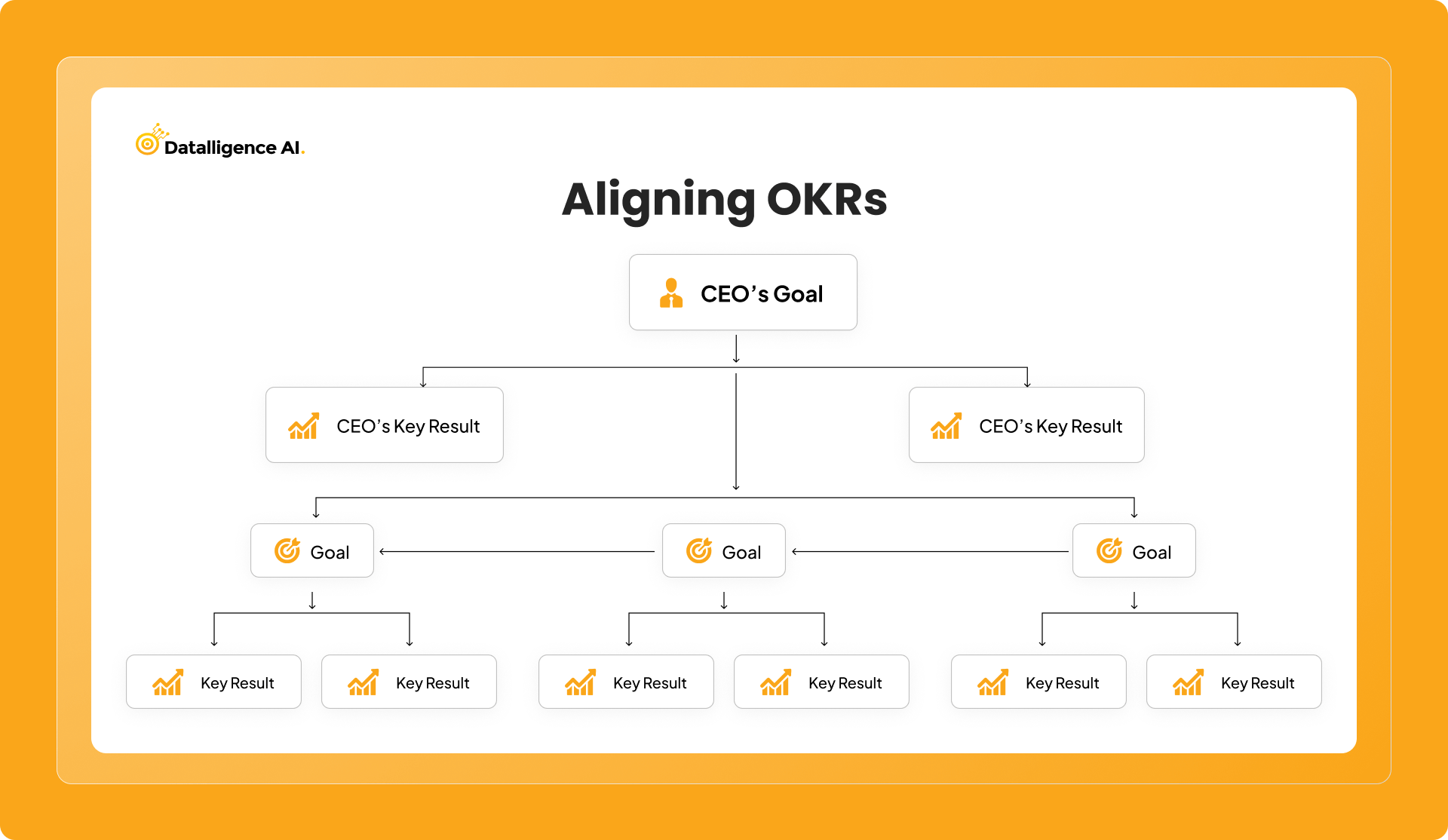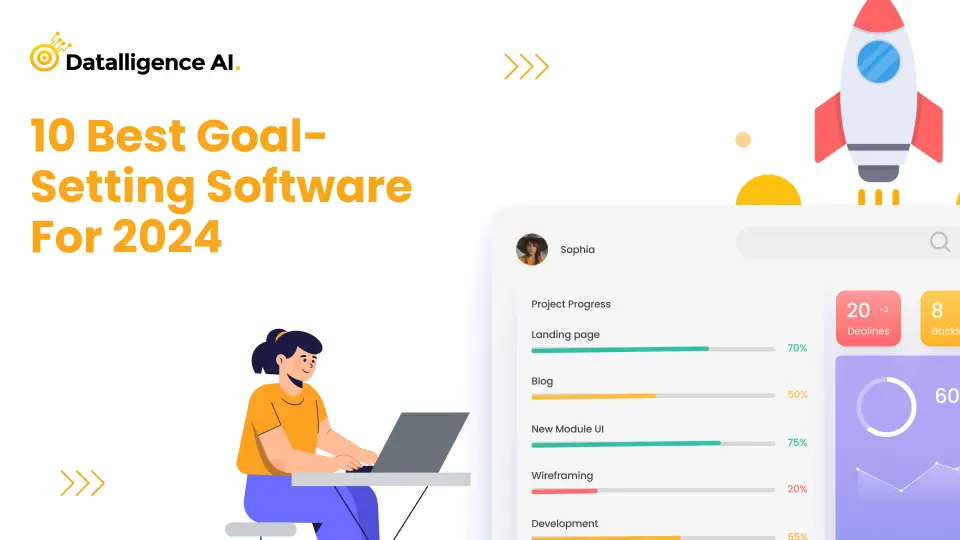Goal setting is a crucial aspect of any organization’s success. However, setting goals is not enough. Without proper execution and visualization, goals can remain mere aspirations. This is where OKR visualization comes into play. OKR, which stands for Objectives and Key Results, is a goal-setting framework that helps organizations set ambitious objectives and define measurable key results to track progress.
OKR visualization involves using tools and techniques to visually represent your goals and track their progress in real-time. By visualizing your OKRs, you can increase transparency, promote collaboration, and align everyone in the organization towards a common purpose. It allows you to see the bigger picture, identify bottlenecks, and make data-driven decisions to drive success.
What is OKR Visualisation and Why is it Important?
Studies have shown that poor execution is one of the main reasons why many corporate plans fail. Without a clear visual representation of goals and progress, it becomes difficult for teams to stay focused and aligned. OKR visualization tips solves this problem by providing a visual dashboard that enables everyone in the organization to see their goals, track progress, and make adjustments as needed.
By visualizing your OKRs, you create a shared understanding of what needs to be achieved and how progress will be measured. It helps teams stay accountable, fosters collaboration, and ensures that everyone is working towards the same objectives. Additionally, OKR visualization allows for better communication and transparency, as it enables teams to share updates, insights, and challenges in a centralized platform.
Now that we understand the importance of OKR visualization, let’s explore some practical tips to make the most out of this powerful tool.
7 Best OKR Visualization Tips
In an age where data drives decisions and goals shape destinies, the way we represent and convey this information becomes paramount. Enter the realm of OKR visualisation—a key tool that brings objectives and key results (OKRs) to life, providing an immediate snapshot of an organization’s progress, priorities, and performance.

Tip 1: Write Clear and Impactful Objectives
One of the key aspects of successful OKR visualisation is writing clear and impactful Objectives. Objectives should focus on the value that the organization aims to create for specific stakeholders. For example, a quarterly Company Objective could be to improve customer satisfaction and make them proud to share your product. This overarching Objective should inspire teams to determine how they can contribute to achieving it.
To effectively visualize your Objectives, it is essential to use qualitative language that resonates with your teams. Clearly communicate the desired impact and the value it will bring to stakeholders. By doing so, you will inspire your teams and provide them with a clear direction to align their efforts.
Tip 2: Choose Measurable Key Results
While Objectives set the direction, Key Results provide the measurable outcomes that determine whether the Objectives have been achieved. Key Results should be specific, measurable, and time-bound. They serve as quantifiable evidence that helps teams measure their progress and outcomes.
When visualizing your OKRs, it is crucial to choose Key Results that can be easily tracked and measured. This allows teams to understand their progress and make data-driven decisions. Aim to select 3-5 Key Results per Objective, ensuring they are aligned with the overall Objective and provide a clear indication of success.
Tip 3: Align OKRs Company-Wide

To maximize the impact of OKR visualisation, it is essential to involve everyone in the organization in the setting and tracking of OKRs. This includes top management, team leaders, and individuals. By involving all stakeholders, you promote transparency, communication, collaboration, and accountability.
Management should set strategic OKRs that align with the organization’s overarching goals, while teams formulate tactical OKRs that contribute to the achievement of those strategic goals. This alignment ensures that everyone understands their responsibilities and can work together towards a common objective. By visualizing and sharing OKRs across the company, you create a sense of unity and purpose through aligning OKRs.
Tip 4: Make OKRs Flexible
While setting goals is important, it is equally crucial to provide flexibility in achieving those goals. OKRs should inspire growth, innovation, and creative problem-solving. By setting aspirational Objectives and Key Results, you encourage your teams to reach for the stars and exceed expectations.
In OKR visualisation, it is important to emphasize the concept of confidence levels. Moonshot goals represent ambitious Objectives that may seem challenging to achieve, but they push teams to aim high. Roofshot goals, on the other hand, are more expected and realistic but still require effort and strategic thinking. By allowing flexibility and acknowledging different levels of achievement, you create an environment that fosters continuous improvement and progress.
Tip 5: Utilize Timelines for Effective Planning
With multiple goals and priorities, it is crucial to allocate sufficient time to each OKR. By assigning timelines to your OKRs, you ensure that teams have the necessary time and resources to achieve their goals. Prioritizing critical issues and setting realistic timelines prevents teams from feeling overwhelmed and helps maintain focus.
Quarterly OKR cycles are commonly used to provide teams with adequate time to work towards their goals. Regular reviews, such as weekly, monthly, and quarterly check-ins, allow teams to track progress, make necessary adjustments, and address any unexpected events. Effective OKR visualisation includes clear timelines and regular reviews to keep everyone on track.
Tip 6: Keep OKRs Simple and Transparent
In many organizations, cross-team communication can be a challenge. To overcome this, OKRs should be written in a way that is easily understandable by anyone in the organization. This promotes transparency and collaboration by writing OKRs in a clear and accessible manner, ensuring that teams can support and align their efforts.
Utilizing OKR software for visualization can greatly simplify the process. It allows teams to easily update, comment, and share insights on key metrics related to the written OKRs. By making OKRs accessible to everyone and providing a platform for clear documentation of written OKRs, teams can understand the goals and progress of other departments, fostering a sense of unity and shared purpose.
Tip 7:Leverage OKR Dashboard Software
To effectively visualize and manage your OKRs, it is highly recommended to leverage OKR dashboard software. These tools provide a centralized platform for tracking, updating, and sharing OKRs across the organization. They offer features such as progress tracking, data visualization, and collaboration, making it easier to monitor and communicate the status of your OKRs.
OKR dashboard software provides a clear overview of the organization’s goals and progress, allowing for better decision-making and communication. It streamlines the OKR process, reduces manual effort, and ensures that everyone is aligned and accountable. By investing in a reliable OKR software, you can maximize the benefits of visualising your OKRs.
Benefits of OKR Visualization through OKR Software

While you can manually track OKRs using spreadsheets or templates, investing in dedicated OKR software can significantly enhance the visualization and management of your goals. OKR software provides several benefits that can help you unleash the full potential of OKR visualization.
1.Maintain Employee Motivation
OKR software allows you to align OKRs company-wide and share relevant updates that help employees understand the connection between their work and the organization’s success. By visualizing the alignment between individual tasks and the big picture objectives, employees can better manage their priorities, stay focused, and motivate themselves to achieve outstanding results.
2.Reduce Managerial Workload with Automations
OKR software automates goal attainment updates, allowing managers to focus on essential tasks such as planning and problem-solving. With customizable templates and automation features, OKR software streamlines the tracking process, making it easier for managers to monitor progress and make data-driven decisions.
3.One Tool for a Clear Overview
OKR software provides a centralized platform where everyone in the organization can track and manage their goals. With real-time data at your fingertips, you can have a clear overview of specific matters, make informed decisions, and communicate clearly across teams and departments.
Get Started with OKR Visualization
If you’re ready to unlock the power of OKR visualization and drive exceptional results, it’s time to get started. Here are some steps to help you embark on your OKR visualization journey:
- Choose the right OKR software: Research and select an OKR software that aligns with your organization’s needs and goals. Look for features such as goal tracking, visualization, collaboration, and automation.
- Define your objectives and key results: Work with your teams to define qualitative objectives and measurable key results that align with the organization’s strategic goals. Ensure that they are clear, specific, and achievable.
- Share and communicate OKRs: Use your chosen OKR software to share OKRs across the organization. Encourage teams to provide regular updates, share insights, and collaborate on achieving their goals.
- Visualize and track progress: Leverage the visualization features of your OKR software to track progress and monitor key results. Use charts, graphs, and dashboards to gain insights and make data-driven decisions.
- Review and adapt: Schedule regular reviews to evaluate progress, identify challenges, and make necessary adjustments. Encourage teams to learn from failures and celebrate successes.
By following these steps and embracing OKR visualization, you can empower your organization to achieve remarkable results and drive continuous improvement.
Conclusion
OKR visualisation is a powerful tool to align strategies, track progress, and drive success. By following these seven tips, you can effectively visualize your OKRs and maximize your goal-setting success. Remember to write clear and impactful Objectives, choose measurable Key Results, align OKRs company-wide, make OKRs flexible, utilize timelines for effective planning, keep OKRs simple and transparent, and leverage OKR dashboard software. With proper visualisation, your organization can achieve its goals and drive continuous improvement.
Remember, OKR visualisation is not a one-time process. It requires regular updates, reviews, and adjustments to stay relevant and effective. By integrating these tips into your OKR visualisation strategy, you can create a culture of transparency, collaboration, and accountability that propels your organization towards success.
So, start visualizing your OKRs today and unlock the full potential of your goals!











